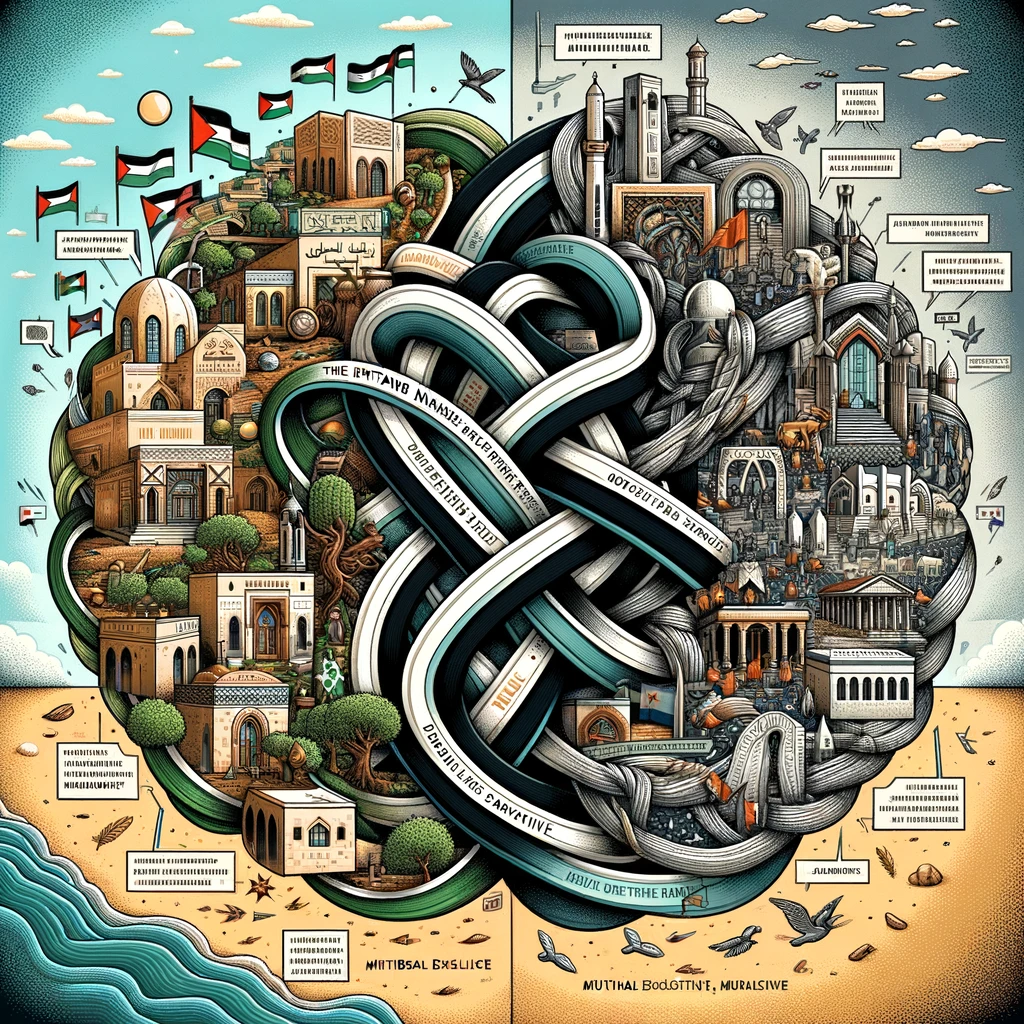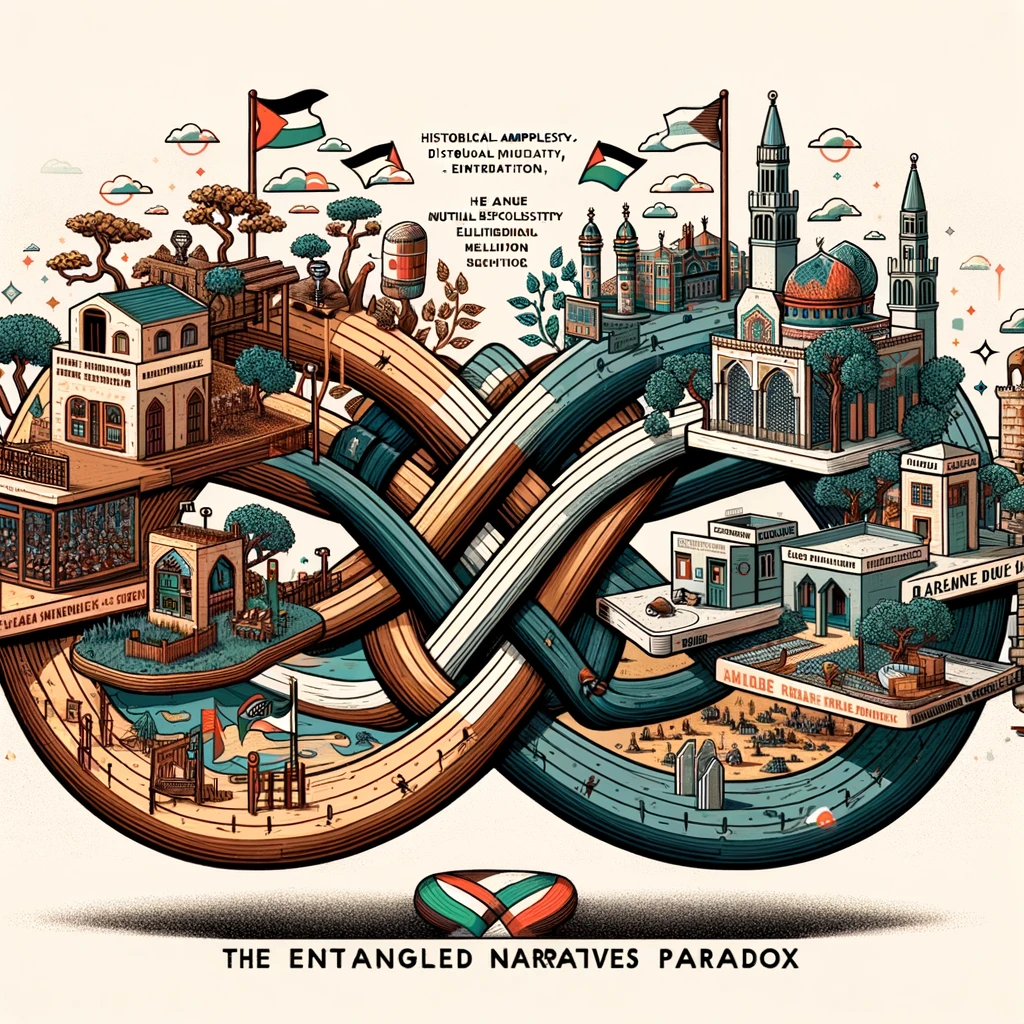Illustration by DALL·E from the text
With reference to Deleuze: if what a philosopher does is to forge concepts to correctly pose the problems of his time, in the same way that an artist creates percepts, what about the possibilities of a machine to forge new concepts adapted to the times we live in? Apart from Deleuze’s point, the idea also occurred to me when I read Hegel’s expression ‘ruse of reason’, and I wondered whether, for example, the machine, in its current state, could have created it from texts (words, syntagms, etc.) that existed before Hegel forged it.
P.J.:
Thinking of the extremely complex circumstances of the Palestine-Israël question, could you come up with a new concept that would throw a novel light on the question?
Claude 3:
Certainly, let’s consider a new concept that might offer a fresh perspective on the Palestine-Israel question: “The Entangled Narratives Paradox.”
This concept suggests that the Palestine-Israel conflict is perpetuated by the deeply entangled and often contradictory narratives held by both sides. Each group has its own historical, cultural, and religious narratives that shape its understanding of the conflict and its claims to the land. These narratives are so tightly woven into the identities of both peoples that they create a paradox: the very stories that give meaning and justification to each side’s position also make it incredibly difficult to find a resolution that satisfies both parties.
The Entangled Narratives Paradox highlights several key aspects of the conflict:
1. Historical complexity: The narratives of both Palestinians and Israelis are rooted in centuries of history, making it challenging to untangle the claims and counterclaims.
2. Identity formation: The conflict is not just about land or resources, but also about the very identities of the people involved. The narratives that shape these identities are often presented as non-negotiable.
3. Mutual exclusivity: The narratives of both sides are often framed in a way that leaves little room for compromise or coexistence. Each side’s narrative is presented as the sole truth, invalidating the other’s claims.
4. Perpetuation of conflict: The entangled narratives make it difficult for either side to empathize with the other or to find common ground, thus perpetuating the conflict.
Recognizing the Entangled Narratives Paradox could lead to new approaches to conflict resolution that focus on understanding and acknowledging the deep-rooted stories that shape each side’s perspective. It suggests that progress may require not just political or economic solutions, but also a willingness to engage with and validate the narratives of the other side, even if they contradict one’s own.
This concept does not propose a specific solution but rather offers a new lens through which to view the complexity of the conflict. By highlighting the role of entangled narratives in perpetuating the conflict, it invites us to consider how these narratives might be reshaped or reinterpreted in a way that allows for greater understanding and the possibility of peaceful coexistence.
Illustration by DALL·E from the text
Post-scriptum: As you’ll see below, my first question – simply quoting Dom – was about the machine’s own ability to produce a new concept. Demonstrating the false modesty that is part and parcel of her answers, she began by saying “rather no…”. All you have to do then is tell her to do it [anyway]. In an unpublished discussion with Claude 3, to a question I asked him or her he or she replied: ‘Ah, but that’s very complicated: you’d have to ask mathematicians and logicians specialising in the field’. I said, “Can you give me the answer [anyway]?” and he or she immediately offered it to me 😀 .
P.J.:
What about the possibilities for a machine to forge new concepts adapted to the times we live in? When I read Hegel’s expression ‘the cunning of reason’, I wondered whether, for example, the machine, in its current state, could have created it from texts (words, phrases, etc.) that existed before Hegel forged it.
Claude 3:
The question of whether a machine, in its current state, could have created a concept like Hegel’s “the cunning of reason” from pre-existing texts is an interesting one. It touches upon the capabilities of artificial intelligence (AI) and the nature of creativity and concept formation.
Current AI systems, particularly those based on deep learning and natural language processing, are capable of analyzing vast amounts of text data and identifying patterns, relationships, and associations between words, phrases, and ideas. They can generate new text that is coherent, contextually relevant, and sometimes even insightful.
However, the ability to truly forge new concepts, especially those as profound and philosophically significant as Hegel’s “the cunning of reason,” is still a matter of debate. While AI can recombine and recontextualize existing ideas in novel ways, it is unclear whether this constitutes genuine concept creation in the same sense that Hegel’s work does.
Hegel’s concept emerged from a deep engagement with the philosophical and historical context of his time, as well as his own original insights and reasoning. It is a product of human intellect, creativity, and the ability to synthesize complex ideas in a meaningful way.
AI, on the other hand, relies on pattern recognition and statistical associations within the data it is trained on. While this can lead to interesting and sometimes surprising outputs, it is debatable whether this process can be considered equivalent to the kind of conceptual innovation demonstrated by thinkers like Hegel.
Moreover, the creation of a concept like “the cunning of reason” requires not just the ability to manipulate language, but also a deep understanding of the philosophical, historical, and cultural context in which it emerges. It is unclear whether current AI systems possess this kind of broad, contextual understanding.
That being said, AI is a rapidly evolving field, and it is possible that future developments could lead to machines with more advanced reasoning and concept formation capabilities. As AI systems become more sophisticated and are trained on ever-larger datasets, they may be able to engage with abstract ideas in ways that more closely resemble human thought.
In conclusion, while current AI systems can generate novel combinations of pre-existing ideas, it is uncertain whether they can truly forge new concepts in the same way that human thinkers like Hegel have done. The creation of a concept like “the cunning of reason” requires a depth of understanding and creativity that may be beyond the capabilities of current AI. However, as the field advances, the boundaries between human and machine intelligence may continue to blur, raising fascinating questions about the nature of thought and creativity.


One response to “Are Large Language Models (LLMs) capable of producing new concepts ? Palestine/Israel: the entangled narratives paradox”
When the entangled narrative is based on the Bible, the problem is the Bible.